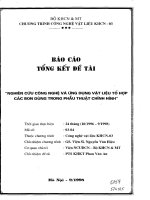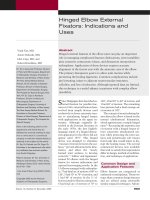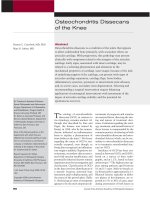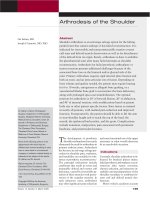Phẫu thuật chỉnh hình pptx
Bạn đang xem bản rút gọn của tài liệu. Xem và tải ngay bản đầy đủ của tài liệu tại đây (136.51 KB, 6 trang )
Office Ambulatory Surgery Centers:
Creation and Management
Neal C. Small, MD, and Jack M. Bert, MD
Abstract
Since the introduction of arthrosco-
py to North America in 1965, the de-
velopment of minimally invasive or-
thopaedic surgical techniques has
steadily progressed.
1
As a result, be-
ginning in the 1980s,
2
some ortho-
paedic procedures were moved from
the hospital environment to the free-
standing ambulatory surgery center
and, more recently, to the ortho-
paedic office ambulatory surgery
center (OASC). Early concern for pa-
tient safety led to preoperative eval-
uation, intraoperative monitoring,
and postoperative care being de-
signed into the centers.
3,4
The cost-effectiveness of OASCs
soon became evident to third-party
payers, as well as to surgeons and
patients. Payers became less reluc-
tant to preauthorize surgery in the
office environment once the issues of
facility charges and patient safety
were addressed to their satisfaction.
The emphasis on cost containment,
which heightened in the early 1990s,
accelerated the development of
OASCs in the mid to late 1990s.
5
However, without state licensure,
Medicare certification, and accredi-
tation, anesthesia restrictions lim-
ited the types of procedures that
could be done in an office operatory.
General anesthesia could not be ad-
ministered in a nonlicensed facility,
and even when local anesthesia or
monitored conscious sedation was
used,
6
most third-party payers
would not preauthorize procedures.
These payers stipulated Medicare
certification as a requirement for
placing the OASC on their panel of
approved facilities. In addition,
licensure by both the state and
Medicare and accreditation by the
Accreditation Association for Am-
bulatory Health Care (AAAHC) or
the Joint Commission on Accredita-
tion of Healthcare Organizations re-
quire appropriate design and con-
struction of these facilities.
7,8
Owners of OASCs responded to
these concerns. Obtaining state li-
censure allowed the use of general
anesthesia, so that the number of
surgical procedures done in the li-
censed OASCs increased.
9
With
Medicare certification and AAAHC
accreditation, virtually all payers, in-
cluding workers’ compensation,
would then reimburse for facility
use in a licensed OASC.
10
Recent
studies have confirmed that outpa-
tient ambulatory orthopaedic sur-
gery is safe, efficient, and cost effec-
tive,
3,5,9
leading to wider acceptance
of OASCs by orthopaedic surgeons.
Benefits of a Licensed
OASC
The proximity of the operating room
to the clinic in an OASC (Fig. 1) im-
proves productivity, efficiency, and
convenience. The surgeon can exam-
Dr. Small is Associate Clinical Professor, Ortho-
pedic Surgery, University of Texas Southwestern
Medical School, Dallas, TX. Dr. Bert is Clinical
Professor, University of Minnesota School of
Medicine, Minneapolis, MN, and President and
Medical Director, Summit Orthopedics, St. Paul,
MN.
One or more of the authors or the departments
with which they are affiliated has received some-
thing of value from a commercial or other party
related directly or indirectly to the subject of this
article.
Reprint requests: Dr. Bert, Suite 307, 17 West
Exchange Street, St. Paul, MN 55102-1034.
Copyright 2003 by the American Academy of
Orthopaedic Surgeons.
Among orthopaedic surgeons, the popularity of in-office ambulatory surgery has
steadily increased. Changing practice patterns, including utilization of office sur-
gery centers, have resulted in improved efficiency and increased revenue. However,
accurate feasibility and market analyses are necessary before considering the addi-
tion of a surgery center to an orthopaedic practice. The legal requirements to op-
erate a center include state licensure, Medicare certification, and accreditation. In
addition, approved construction design and effective operations management are
essential.
J Am Acad Orthop Surg 2003;11:157-162
Perspectives on Modern Orthopaedics
Vol 11, No 3, May/June 2003 157
ine patients and provide office care
while the operating room is being
prepared for the next procedure.
Some surgeons have reported a sav-
ings of as many as 8 hours per week
because of this single improvement
in practice efficiency.
11
Patient satisfaction is usually
quite high among those who have
undergone a procedure in an
OASC.
12
Patients may feel less anx-
ious in the office environment as op-
posed to that of the hospital. Results
of satisfaction surveys indicate that
patients appreciate the amount of
personal attention they receive, par-
ticularly in postanesthesia recovery
(Fig. 2). Patients’ families also report
a high satisfaction rate.
The OASC appears to be more
cost effective than either the hospital
operating room or the hospital out-
patient surgery department.
5,9
The
fees for freestanding OASCs, which
are scheduled to take effect on July
1, 2003, have been published in the
Federal Register.
13
OASC facility fees
are to be reimbursed at a lower rate
than hospital facility fees because
the cost to deliver a procedure is less
for an OASC than for a hospital.
An example of the difference be-
tween Medicare-allowable facility
fees for the hospital outpatient sur-
gery department compared with
those for the OASC can beillustrated
using Current Procedural Terminology
(CPT) code 29881 (arthroscopic men-
iscectomy). The Centers for Medi-
care & Medicaid Services published
a proposed ambulatory payment
classification group payment rate of
$1,048 for CPT code 29881 when the
procedure is done in the hospital
outpatient surgery department.
14
The facility reimbursement to
OASCs published in the Final Rule
of the Centers for Medicare & Med-
icaid Services is $630.
13
This differ-
ence in facility fees is a direct result
of the substantially lower costs re-
quired to perform surgery in non-
hospital facilities.
15
Even though
most third-party payers reimburse
for facility use at a higher level than
Figure 1 A, Single operating room. B, Double operating room.
Figure 2 Postanesthesia recovery area.
Office Ambulatory Surgery Centers
158 Journal of the American Academy of Orthopaedic Surgeons
the Medicare-allowable rate, payers
nevertheless perceive the OASC to
be cost effective compared with hos-
pital operating rooms and hospital
outpatient surgery departments.
Creating an OASC
Individual state laws regarding
health care facilities development
must be studied before creating an
OASC because some states require a
certificate of need, which allows the
physician group to construct the
proposed facility. Obtaining a certif-
icate of need may involve local or
statewide political issues because of
possible resistance to physician-
owned surgery centers by local hos-
pitals. Some states have dropped the
certificate of need requirement, are
in the process of doing so, or are re-
viewing the law; other states have
exemptions for single-specialty
OASCs. Several states have certifi-
cate of need exemptions allowing fa-
cilities to be constructed with expen-
diture limitations. Despite strong
opposition by hospital lobbyists, it
appears that certificate of need re-
quirements are being steadily re-
duced.
7
The process of planning, design-
ing, and building an OASC, as well
as obtaining licensure, certification,
and accreditation, takes approxi-
mately 1 year to 18 months to com-
plete and can be divided into five
phases: phase 1, feasibility and mar-
ket analysis (approximately 1
month); phase 2, legal issues and de-
sign (3 months); phase 3, construc-
tion and staffing (6 months or more);
phase 4, licensing and Medicare re-
quirements (2 months); and phase 5,
accreditation (optional but recom-
mended).
Phase 1: Feasibility and Market
Analysis
A feasibility analysis should be
done to determine whether a clinic
should build an OASC. A limited
preliminary analysis can help deter-
mine whether the clinic should ex-
pend the time and incur the expense
of a full feasibility analysis and pro
forma.
The detailed feasibility analysis
involves evaluating the explanations
of benefits for the surgical proce-
dures as well as analyzing by CPT
code the procedures done by each
surgeon. The subspecialty mix of the
surgeons and the average operating
time per procedure of each must be
assessed. Fee schedules and collec-
tion percentages must be analyzed.
In addition, local construction costs
must be reviewed. Many other fac-
tors, including a cost analysis for the
facility, are used to determine likely
gross revenues and net profitability
of the OASC. When the feasibility
analysis is complete, the analyst can
determine if the practice entity is an
appropriate candidate for an OASC.
A market analysis is critically im-
portant, as well. By reviewing the
marketplace, assessing the competi-
tion, and performing a payer analy-
sis, the practice will be able to deter-
mine whether it should proceed
with development or whether the
market forces and payers in the area
will restrict the practice from refer-
ring patients to its surgical unit. Be-
cause the cost of an OASC can be sig-
nificant, the importance of the
feasibility and market analyses can-
not be underestimated. These analy-
ses provide the necessary informa-
tion to decide whether the OASC
should be built and, if so, what size
the facility should be.
Phase 2: Legality and Design
Before proceeding with design
and construction, the practice may
wish to form a new legal entity, such
as a limited liability corporation, to
own and operate the OASC. Legal
counsel should study the ownership
alternatives and create the entity.
Also, the new entity should have a
billing number different from that of
the practice itself.
A medical architect will work
with the state licensure board to
ensure that the OASC is designed
according to state guidelines and
within Medicare-specific design re-
quirements. This design process var-
ies considerably depending on the
size of the facility and whether it will
require remodeling of or addition to
existing space or necessitate new
construction.
Phase 3: Construction and
Staffing
The construction phase may last
from a few months to a year or more.
An architect and construction firm
familiar with code requirements for
medical facilities can eliminate cost-
ly revisions. Contracting with third-
party payers also must begin during
phase 3.
The OASC staff should be hired
during this phase. The nurse manag-
er should be brought on early to as-
sist in ordering equipment, materi-
als, and supplies appropriate for the
procedures to be done in the facility.
Consultants can aid in this process.
The OASC owners can either direct-
ly hire staff necessary for payer rela-
tions and financial management or
use the services of a company with
experience in OASC management.
The anesthesia staff should be se-
lected during this phase to assist with
the installation and testing of an-
esthesia machines and monitoring
equipment, as well as related items.
Some practice-owned centers provide
ownership interests for some or all
of the anesthesia staff, but most work
with independent anesthesiologists
who have no financial interest in the
OASC. Sometimes the anesthesiolo-
gist is employed by the center, which
then bills for anesthesia professional
services provided during surgery.
Phase 3 concludes when a certificate
of occupancy is obtained.
Phase 4: Licensing and Medicare
Phase 4 includes the state licen-
sure process and Medicare certifica-
Neal C. Small, MD, and Jack M. Bert, MD
Vol 11, No 3, May/June 2003 159
tion. State licensure is required for
Medicare certification. To achieve
state licensure and eventual Medi-
care certification, requirements must
be met in several areas, including fa-
cility design and construction. De-
tailed documentation of such items
as appropriate committee meetings
and staff credentialing also is neces-
sary (Table 1).
Phase 5: Accreditation
Accreditation is optional, but
some payers require accreditation in
addition to licensure and certifica-
tion. Accreditation can be obtained
from the AAAHC or the Joint Com-
mission on Accreditation of Health-
care Organizations.
Anticipating and
Correcting Potential
Problems
Substantial preliminary payer nego-
tiations, accomplished payer mar-
keting, and professional manage-
ment are necessary for a successful
OASC. Because of stringent state li-
censure, Medicare, and AAAHC re-
quirements, problems for the OASC
rarely involve issues of patient safe-
ty or operating room quality. The
usual reasons that facilities do not
function at maximum capacity are
management difficulties with such
procedures as contracting, schedul-
ing, or billing. Underutilization may
occur because of problems with pay-
er contracting, scheduling, patient
flow, and inventory management.
Contracting difficulties should be
minimal or nonexistent because cost
savings and patient preference for the
OASC have led to acceptance by most
payers. Although scheduling and pa-
tient flow issues may be a potential
problem, software programs can elim-
inate much of the complexity for the
nurse manager and scheduler. Sup-
ply inventories often are inappropri-
ate for the OASC caseload; many
OASCs struggle with either inade-
quate stock or an overabundance of
certain supplies. Inventory control
software can helpwith these problems.
Staffing inconsistencies are among
the most common difficulties encoun-
Table 1
Medicare Requirements for OASC Certification
Structural The design must comply with state health facilities commission structural guidelines.
The operating room must be at least 250 sq ft.
The OASC must have a separate recovery room and waiting room.
The OASC must meet Life Safety Code standards of the National Fire Protection Association.
Policies and
procedures
The OASC must have a governing body.
The OASC must perform ongoing quality assurance.
All medical staff must be credentialed by a credentialing committee.
Medical privileges must be periodically reappraised by the OASC credentialing committee.
Policies and procedures must exist for nonmedical personnel.
Patient safety All OASC personnel must be trained to use emergency medical equipment.
A registered nurse must be in attendance whenever a patient is in the OASC.
Awritten transfer agreement must be in effect with a local hospital, and all surgeons using the facility
must be on the staff of that hospital.
Emergency
equipment
The OASC must have comprehensive emergency equipment, including emergency call system;
oxygen; mechanical ventilatory assistance, including airways, manual breathing bag, and ventila-
tor; cardiac defibrillator; cardiac monitor; tracheotomy set; laryngoscopes and endotracheal tubes;
suction equipment; and other emergency medical equipment specified by the medical staff.
Ancillary services
and contracts
The OASC must provide pharmaceutical services under the supervision of a pharmacy director.
The OASC must have its own laboratory or must use a Medicare-certified laboratory.
The OASC must use a Medicare-certified radiology facility.
Administrative Medical records identical to hospital records must be developed and maintained.
Random surveys of the OASC by the Centers for Medicare & Medicaid Services must be anticipated.
The OASC must maintain accurate financial records containing data that enable the Centers for
Medicare & Medicaid Services to determine payment rates for covered surgical procedures.
Office Ambulatory Surgery Centers
160 Journal of the American Academy of Orthopaedic Surgeons
tered by newly opened OASCs. De-
spite the fact that staffing usually be-
gins in phase 3, some clinics are
unable to hire qualified personnel
quickly enough. Many OASCs per-
form 200 or more procedures per
month soon after obtaining licensure,
certification, and accreditation. The
OASC nurse manager may be unable
to provide adequate staffingif person-
nel needs are not fully addressed well
in advance of opening. Understaffing
risks inadequate patient care, while
the expense of overstaffing impairs
OASC profitability. The use of part-
time employees may be advisable.
Also, continuing education for OASC
personnel is important to maintain
quality patient care and employee
morale.
Some facilities have problems
with CPT coding, billing, and collec-
tion of OASC facility fees, particular-
ly in the first several months after
opening. Difficulties with CPT cod-
ing and collection of facility fees can
severely compromise a clinic’s over-
all cash flow. The facility fee revenue
represents at least one third of the
gross revenue for a typical ortho-
paedic group practice with an
OASC. Some practices have been
overwhelmed by the additional bill-
ing volume and frustrated by a cash
flow shortage during the start-up
phase. This problem can be avoided
with proper forecasting, training,
and preparation.
11
Many practice entities do not ad-
equately anticipate the debt service
and other ongoing overhead expens-
es that begin even before the OASC
is opened. These anticipated costs
necessitate that the center secure a
line of credit several months before
opening. It can take at least 90 to 180
days before the facility fee reim-
bursements compensate for ongoing
expenses such as salaries, rent, and
other costs. Because payers often are
unfamiliar with the new billing en-
tity, the claims process is slower than
when the professional fee claims are
reviewed. This collection window
for accounts receivable decreases
considerably once payers become fa-
miliar with the new facility.
Allowable facility fees must be
well understood, and in some in-
stances it is beneficial to accept out-
of-network benefits for facility use
because of improved reimburse-
ment. Discounted contracts usually
are not advisable unless they repre-
sent significant volume and the re-
imbursement is greater than the cost
of the service provided. Hiring or
consulting with a contracting spe-
cialist familiar with the nuances of
OASC reimbursement can be of
great benefit.
Enjoying the OASC
The quality of professional life that
the OASC provides surgeons is be-
yond the expectations of most.
16,17
The importance of operating in a
comfortable, well-conceived envi-
ronment of one’s own design should
not be underestimated. The surgeon
can make reasonable changes with-
out dealing with the layers of ad-
ministration and committees typical
of the hospital environment. Sur-
geons who have completed an
OASC often wonder why they wait-
ed so long to simplify their profes-
sional lives and enjoy improved
practice profitability. As technology
progresses and appropriate facilities
are completed, and if insurance re-
imbursements are allowed, many
minimally invasive procedures now
performed in the hospital may be
done in an OASC. This is also a trend
in other specialties, such as ophthal-
mology, otolaryngology, plastic sur-
gery, and urology.
Summary
Office ambulatory orthopaedic sur-
gery has become an increasingly
widespread method for delivering
certain types of orthopaedic surgical
care. In many states, there has been
a transition from traditional
hospital-based and freestanding am-
bulatory surgery centers to practice-
owned OASCs. States requiring a
certificate of need may delay or pre-
vent the development of OASCs, al-
though certain exemptions may be
available in some states with certif-
icate of need requirements; these ex-
emptions should be carefully re-
searched. Legislative changes are
under way in many states to modify
or eliminate the certificate of need
process. Orthopaedic surgeons
should be aware of the stringent re-
quirements for securing state licen-
sure and Medicare certification for
the OASC. In addition, a somewhat
lengthy process from feasibility
analysis to facility completion
should be anticipated. However, an
OASC can help a practice contain
medical costs, improve efficiency,
control the surgical environment,
and enhance patient satisfaction.
The practice group can help ensure
a high quality of orthopaedic care
by hiring their own surgical staff.
Properly managed, the OASC can
provide an additional source of rev-
enue to offset declining reimburse-
ments.
Neal C. Small, MD, and Jack M. Bert, MD
Vol 11, No 3, May/June 2003 161
References
1. Small NC (ed): Office Operative Arthros-
copy. New York, NY: Raven Press, 1994.
2. Hall MJ, Lawrence L: Ambulatory sur-
gery in the United States, 1996. Adv
Data 1998;12:1-16.
3. Rohrich RJ, White PF: Safety of outpa-
tient surgery: Is mandatory accreditation
of outpatient surgery centers enough?
Plast Reconstr Surg 2001;107:189-192.
4. Williams BA, DeRiso BM, Figallo CM,
et al: Benchmarking the perioperative
process: III. Effects of regional anesthe-
sia clinical pathway techniques on pro-
cess efficiency and recovery profiles in
ambulatory orthopedic surgery. J Clin
Anesth 1998;10:570-578.
5. Novak PJ, Bach BR Jr, Bush-Joseph CA,
Badrinath S: Cost containment: Acharge
comparison of anterior cruciate ligament
reconstruction. Arthroscopy 1996;12:160-
164.
6. McGuire DA, Sanders K, Hendricks
SD: Comparison of ketorolac and opi-
oid analgesics in postoperative ACL re-
construction outpatient pain control.
Arthroscopy 1993;9:653-661.
7. Becker S, Biala M: Ambulatory surgery
centers: Current business and legal is-
sues. J Health Care Finance 2000;27:1-7.
8. Small NC: Building a successful practice-
owned, office-based ambulatory surgery
center. Am J Knee Surg 2000;13:241-244.
9. Nogalski MP, Bach BR Jr, Bush-Joseph
CA, Luergans S: Trends in decreased
hospitalization for anterior cruciate lig-
ament surgery: Double-incision versus
single-incision reconstruction. Arthros-
copy 1995;11:134-138.
10. Brown S:Accreditationofambulatorysur-
gery centers. AORNJ 1999;70:814-818, 821.
11. Bert JM: Pros and cons of practice-owned
and office-based ambulatory surgery cen-
ters. Am J Knee Surg 2000;13:245-248.
12. Small NC, Glogau AI, Berezin MA, Far-
less BL: Office operative arthroscopy of
the knee: Technical considerations and
a preliminary analysis of the first 100
patients. Arthroscopy 1994;10:534-539.
13. />2422/14mar20010800/edocket.access.
gpo.gov/2003/pdf/03-7236.pdf. Ac-
cessed April 18, 2003.
14. McLelland M: The financial effect of
ambulatory payment classifications.
Manag Care Interface 1999;12:67-70.
15. Owings MF, Kozak LJ:Ambulatory and
inpatient procedures in the United States,
1996. Vital Health Stat 13 1998;139:1-119.
16. Bert JM: The efficient, enjoyable, and
profitable orthopedic practice. Clin
Sports Med 2002;21:321-325.
17. Bert JM: Office based arthroscopy cen-
ter. Outpatient Surgery 2000;1:11-13.
Office Ambulatory Surgery Centers
162 Journal of the American Academy of Orthopaedic Surgeons









